How to Make Butane Honey Oil
| Added by:
snoofer Last edited by:
snoofer Viewed: 68 times |
Rated by 21 users:
9.19/10 |
Contributed by: Phife
Submitted: November 27th, 2004 Images archived:
2005 Disclaimer 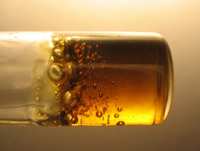 Butane
Honey Oil (BHO) extraction is an extremely dangerous
activity. Butane is flammable, explosive and can
potentially contain poisonous and harmful chemicals.
Undertaking BHO extraction may result in serious bodily
injury, or Death. The information provided on this
website is strictly for educational purposes and in no
way do the owners and staff of Overgrow.com encourage
its production or use. Safety
Butane is Highly Flammable and ALL extractions
are to be done Outdoors Only, doing extractions indoor
is extremely dangerous. There have been accounts of
people blowing up their houses, kitchens, and bathrooms
doing Butane and other solvent extractions indoors!
Butane gas is heavier than air and will pool in
low areas, if left to collect butane gas becomes
flammable when it reaches 1.8% to 8.5% concentration in
air. A small breeze will keep the butane from being able
to pool and become dangerous. It is recommended
you take every precaution possible. Wearing Safety
Equipment such as Eye protection, as well as gloves and
always keep a fire extinguisher near by.
Nothing is more important than your safety!
Do all butane extractions Outdoors or in Very well
ventilated areas.
Never Smoke, have an open
flame or source of ignition around when doing any kind
of extraction, even outdoors
Avoid static build up and even a small spark in the
right conditions can be dangerous.
Butane
& Health
It has been talked about a lot
lately, some brand of butane add a smell to their
butane. This smell is usually added to the butane so
that humans can detect leaks, you will find it in large
amounts in cheap butane, or camping butane. It can also
potentially be in ?Clean? butane such as Colibri.
These chemicals are usually Mercaptans or Sulfur
Dioxide (Rotten Egg Smell), using cheap butane with high
levels of these is harmful. Do not use cheap butane or
camping butane. It can also be harmful to use ?Clean?
butane, so do so at your own risk.
It is not
known what the effects of residues in butane honey oil
are; it?s not even known for sure what if any residues
are left over in butane honey oil after the butane is
purged.
Only a Gas Chromatography/Mass
Spectrometer can give us the info on what?s exactly is
in our BHO. The search is on to find somewhere to get a
sample tested. Until then, be aware of the potential
health risks and judge for yourself if it?s worth it.
Butane Brands
Not all butane is
created equally; there are 2 different types of butane
that make up the most common brands of butane. Isobutane
and N-Butane.
Most cheap brands use Isobutane
(2-METHYL PROPANE) and is more toxic and hazardous than
N-Butane. For making Honey oil N-Butane is what we want,
it extracts better and leaves very little to no residues
in the oil.
Other brands use a mix of the
different types, and some, like Colibri, use propane as
well as Iso and n-butane
Boiling Points
ISOBUTANE: -11.7 C
N-BUTANE: -0.5 C
No
source of pure N-Butane has been found available in
stores, only through Gas Supply Companies.
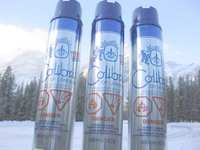 The best
brand of butane I have used is Colibri Butane. I highly
recommend Colibri, and you should be able to find it at
most Fine Cigar and Tobacco Shoppe?s. Below is a list of
other brands that are good for making Honey oil with. If
you cannot find Colibri try to find one of the butane
brands listed. And by all means avoid Ronson,
Bernz-o-matic or other butane not listed below, they add
smell to their butane and this smell is left behind
making the oil taste very bad. The best
brand of butane I have used is Colibri Butane. I highly
recommend Colibri, and you should be able to find it at
most Fine Cigar and Tobacco Shoppe?s. Below is a list of
other brands that are good for making Honey oil with. If
you cannot find Colibri try to find one of the butane
brands listed. And by all means avoid Ronson,
Bernz-o-matic or other butane not listed below, they add
smell to their butane and this smell is left behind
making the oil taste very bad.
Other Brands
that are good to use:
COLIBRI, NEWPORT,
CORA, CTC, COLTON, DUNHILL, DAVIDOFF, FACKELMAN, WIN,
NIBO, SAROME, CALOR GAS MATCH, UNILIGHT, K2, SUPERGAS,
VENTTI, VECTOR.
This is by no way a complete
list, and there is no promise this info will always be
correct, manufactures can change recipes at anytime.
This list is the brands that carry the ?Near Zero?
impurity label, which means they are not supposed to
have more than 15ppm of impurities, what they are is not
know.
When you purchase the butane make sure you
find the largest size of can you can. I use the
300ml/167g (6oz) cans of Colibri. Most places only carry
the little 2oz cans, these are not enough. You will need
at least 8oz of butane for every 1oz of plant material.
If you find a brand that?s not listed you can do
the mirror test to check to see if it?s ok to use. See
Below.
Mirror Test
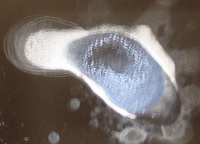 Take a
mirror or piece of glass and spray some liquid butane
into it. A good amount. (You may need some pliers to
press the nozzle in) Wait about 5-10mins for the butane
to evaporate and check the mirror for a white residue
like the kind pictured. The residue also smells bad.
Don?t confuse water condensation for residue. Also even
Colibri leaves a very slight residue, but it doesn?t
smell. Check for Smell. Take a
mirror or piece of glass and spray some liquid butane
into it. A good amount. (You may need some pliers to
press the nozzle in) Wait about 5-10mins for the butane
to evaporate and check the mirror for a white residue
like the kind pictured. The residue also smells bad.
Don?t confuse water condensation for residue. Also even
Colibri leaves a very slight residue, but it doesn?t
smell. Check for Smell.
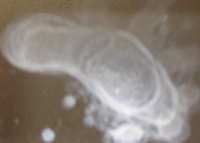 (First
mirror picture is of a clean mirror, second of the
butane evaporating and last one is the white residue
from Bernz-o-matic brand butane) (First
mirror picture is of a clean mirror, second of the
butane evaporating and last one is the white residue
from Bernz-o-matic brand butane)
Plant Material
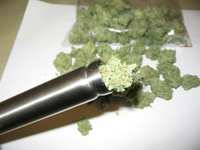 This is
the most important factor if you wish to achieve high
quality honey oil, Good fresh dried uncrushed bud makes
the best honey oil, and you should easily achieve clear
oil using uncrushed buds. Grind them up and do a second
extraction to get a lower grade ?B? wash, not as tasty
or clear like the first batch. This is
the most important factor if you wish to achieve high
quality honey oil, Good fresh dried uncrushed bud makes
the best honey oil, and you should easily achieve clear
oil using uncrushed buds. Grind them up and do a second
extraction to get a lower grade ?B? wash, not as tasty
or clear like the first batch.
Butane extracts
the smell from the plant material, so if you have some
great smelling buds the oil will also take on that
smell. If you use bad smelling or tasting plant
material, you will get bad tasting oil.
Using
crappy plant material can also result in low yield and
oil dark in color.
Plant
Material-|-Recommended amount Butane-|-Estimated
Yield
1oz High quality bud-|-12oz-|-3-6g
1oz
Average bud-|-10oz-|-2-4g
1oz low grade
bud-|-9oz-|-2-3g
1oz high quality trim
leaves-|-12oz-|-3-5g
1oz trim &
leaves-|-10oz-|-2-4g
1oz fan leaves-|-8oz-|-1-2g
Extraction Tube
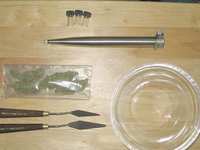 The
extraction tube should be no wider than 1.5?, I find ?
to be the best. The tube should be made of Stainless
steel or Thick glass Only, You can use a copper tube if
you cannot find stainless or glass, but only if you
clean the tube well before each extraction. Copper
tarnishes and the tarnish can potentially be extracted
by the butane. The
extraction tube should be no wider than 1.5?, I find ?
to be the best. The tube should be made of Stainless
steel or Thick glass Only, You can use a copper tube if
you cannot find stainless or glass, but only if you
clean the tube well before each extraction. Copper
tarnishes and the tarnish can potentially be extracted
by the butane.
Avoid ALL Plastics, brass, steel
and galvanized steel pipe, these all can contaminate
your oil and make you sick.
I found a cheap
stainless steel turkey baster works very well with
little modification. It holds about 1/2oz of bud and can
yield 2.5-3g of oil from oz of good bud and 4-5oz of
butane.
Some people like to build a contained
extraction tube with valves to hold the butane in and
let it sit in the plant material for a long time to
maximize extraction but this is unnecessary. An open
ended tube where the butane can flow through and drip
into a collection dish is the easiest to build and makes
much better oil. Allowing the butane to sit in the plant
material will make your oil greener.
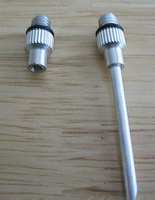 I use a ?
by 9? Stainless Turkey Baster tube with a screw cap top
and a small hole for the butane nozzle. Use a drill to
make a 7/64? hole. Leave the bottom Open Ended, a paper
basket style coffee filter, and stainless steel screen
or metal window screen will be attached here when the
tube is filled with the plant material. Use a Hose Clamp
to attach your filters. I use a ?
by 9? Stainless Turkey Baster tube with a screw cap top
and a small hole for the butane nozzle. Use a drill to
make a 7/64? hole. Leave the bottom Open Ended, a paper
basket style coffee filter, and stainless steel screen
or metal window screen will be attached here when the
tube is filled with the plant material. Use a Hose Clamp
to attach your filters.
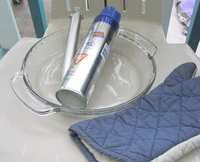 For the
collection dish I use a Pyrex casserole or pie dish.
Avoid metal collection dish as they can spark, you can
use them but I don?t recommend it. For the
collection dish I use a Pyrex casserole or pie dish.
Avoid metal collection dish as they can spark, you can
use them but I don?t recommend it.
Honey oil is
very sticky and it?s a lot easier to scrape it up from a
flat bottom dish with square sides or one with out
corners but I have yet to find the perfect dish, Make
sure your collection dish can hold at least 500ml of
liquid.
Extraction
Make
sure your plant material (Leaves, Trim, Stems, or Buds)
are very dry, the dryer the better. If you want clear
honey oil with a lower yield, pack the tube without
grinding or breaking up the plant material. The butane
will extract the high quality oil on the outside of the
plant material then unpack the tube, Grind up the plant
material into a powder, you don?t want any chunks in it,
it should a coarse powder, and re-extract a lower grade
oil.
The better the starting material the better
the oil. If you use males or just fan leaves don?t
expect awesome oil. You can also use butane extraction
to salvage moldy buds.
Fill the extraction tube
full with the powdered plant material; avoid making air
pockets in the tube. I like to fill the tube a little
then pack it down and repeat until the tube is full.
Don?t pack it to much and try to make sure the
tube is full, if you don?t have enough plant material to
fill your tube then try to get a smaller tube. Air
pockets let the liquid butane expand to gas and lower
the efficiency a little.
After your tube is
filled then you can place your screen on the bottom,
Coffee filter works well. The picture shows a steel mesh
screen with a coffee filter, which would work the best.
Find some way to mount the tube on a stand or
get an oven mitt as the tube gets very cold, and you
won?t be able to hold it with your bare hand for very
long.
Once the tube is filled and prepared its
time to get your collection dish, tube, butane and stand
or glove and venture outdoors.
This is the
most dangerous part of the whole process:
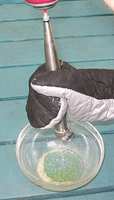 Find a
safe, secluded place where you can do the extraction.
Hold or mount the tube over the collection dish and
place the nozzle of the butane can in the hole you made
in the end cap. Release the entire can of butane into
the tube, it will take anywhere from 30 secs. To 1 min
for the liquid to start to drip from the bottom of the
tube into the collection dish. If no liquid comes out of
the tube and you have used an entire can then get
another can, Packing the plant material to tight can
cause a build up of pressure and stop the butane from
flowing, if this happens do not let the pressure build
to high and take your time.. Eventually the butane will
make its way out the bottom. If the butane starts to
come out the top hole then slow the release of butane
into the tube. Find a
safe, secluded place where you can do the extraction.
Hold or mount the tube over the collection dish and
place the nozzle of the butane can in the hole you made
in the end cap. Release the entire can of butane into
the tube, it will take anywhere from 30 secs. To 1 min
for the liquid to start to drip from the bottom of the
tube into the collection dish. If no liquid comes out of
the tube and you have used an entire can then get
another can, Packing the plant material to tight can
cause a build up of pressure and stop the butane from
flowing, if this happens do not let the pressure build
to high and take your time.. Eventually the butane will
make its way out the bottom. If the butane starts to
come out the top hole then slow the release of butane
into the tube.
Continue to empty the can until
its just releasing gas (you will hear the difference),
remove the spent can. If you are extracting more than
1oz get another can. I usually run 1 6oz can as my tube
will hold about 1/2oz of plant material.
After
the last can is emptied I let the tube drip for another
few mins, the liquid in the dish should have a golden
color to it. It may be hard to see.
Evaporation
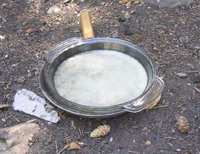 I like to
bring a thermos filled with boiled water to my
extraction location along with a frying pan so I can do
the evaporations outdoors. It should only take about
15-20mins to evaporate it all. I like to
bring a thermos filled with boiled water to my
extraction location along with a frying pan so I can do
the evaporations outdoors. It should only take about
15-20mins to evaporate it all.
Or you can do
your evaporations indoors as long as you take every
precaution and are aware of the risk of fire if a spark
or flame reaches the evaporating butane. And be sure not
to let it pool in low areas.
I have a small fan
close by blowing at the dish to avoid butane pools but
the electric motor can cause sparks so be sure to keep
it blowing at the butane instead of sucking the butane
out.
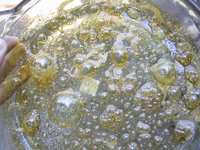 Place the
collection dish into a larger dish or frying pan filled
with hot tap water or water that was boiled and watch
the butane start to bubble. The hot water will get cold
quickly so change it often until the butane/oil mix
starts to thicken up. Place the
collection dish into a larger dish or frying pan filled
with hot tap water or water that was boiled and watch
the butane start to bubble. The hot water will get cold
quickly so change it often until the butane/oil mix
starts to thicken up.
Once the oil gets thicker
I let it cool in the freezer in the collection dish. I
recommend you do another heating with hot water to make
sure all the butane is evaporated.
Be careful
not to overheat or evaporate for too long. The longer
you apply heat the darker your oil will get. Once the
oil no longer bubbles from boiled water then its usually
ready, no more heat is needed.
The oil might
still bubble when a lighter is applied but this is not
butane gas bubbles. It?s just the nature of the honey
oil.
If you find your honey oil gets hazy or
cloudy it is usually cause by trapped butane, do another
purge to get the last of the butane out.
Once
your done evaporating the butane, the honey oil can be
smoked. If you let the honey oil sit in the collection
dish, keep it covered in a dark place for a week - the
honey oil will harden and you can chip it off, it will
be solid but melt when heated.
Handling,
Storing and Smoking:
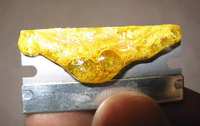 You can
use a razor blade to scrape up the oil from the dish. I
like to put my oil into 5g Glass vials for storage; you
should be able to find the vials at your local head
shop. It?s pretty tricky to fill the vials with oil and
it will take a bit of practice to get it right. You can
use a razor blade to scrape up the oil from the dish. I
like to put my oil into 5g Glass vials for storage; you
should be able to find the vials at your local head
shop. It?s pretty tricky to fill the vials with oil and
it will take a bit of practice to get it right.
You can leave the oil in the collection dish and
scrape it as you smoke it as well, make sure you cover
the dish with plastic wrap so no dust and other things
get stuck in your oil.
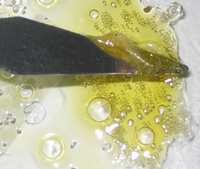 Depending
on your collection dish shape, it might be difficult to
remove all the oil from the corners. I found a little
tool that works very well for getting all the oil from
the dish. It?s used for mixing paints and it looks like
a little flexible knife that can bend to get in all the
corners. It?s called a Palette knife and you should be
able to find that at an art supply store. Depending
on your collection dish shape, it might be difficult to
remove all the oil from the corners. I found a little
tool that works very well for getting all the oil from
the dish. It?s used for mixing paints and it looks like
a little flexible knife that can bend to get in all the
corners. It?s called a Palette knife and you should be
able to find that at an art supply store.
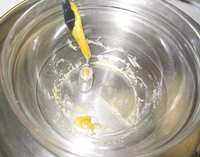
Smoking
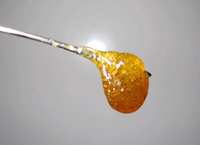 I like to vaporize my oil on hot knives,
Take a butter knife and stick it between the electric
elements in your stove and crack up the heat, or use a
butane or propane torch to heat the knife up. When it?s
nice and hot remove the knife and use a pin to drip a
drop of oil on the hot knife and suck up the smoke with
some sort of tube. I use a pen tube or custom glass
hooter. I like to vaporize my oil on hot knives,
Take a butter knife and stick it between the electric
elements in your stove and crack up the heat, or use a
butane or propane torch to heat the knife up. When it?s
nice and hot remove the knife and use a pin to drip a
drop of oil on the hot knife and suck up the smoke with
some sort of tube. I use a pen tube or custom glass
hooter.
Ash bowls are another common way to
smoke oil. Take a pipe or bong and fill the bowl with
ashes from a cigarette and then drip a drop of oil on
top of the pile of ashes. Then light the bowl with a
lighter and smoke like you normally would.
Well
that?s it Folks. How to make kick ass honey oil! Good
Luck to all and Be Safe.
|
| Last modified: 03:40 - Jan 27,
2005 |
| |